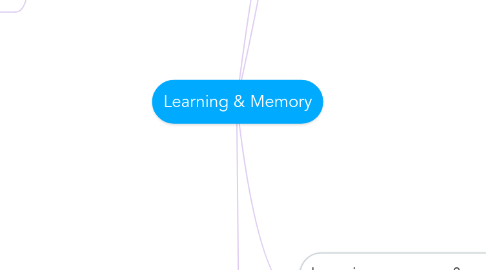
1. Neural memory processes
1.1. Classical & non-associative learning
1.1.1. associative learning
1.1.1.1. Hebb – fire together, wire together (associative learning)
1.1.1.2. Hebbian synapse: increased efficacy due to synchronous pre & postsynaptic activity
1.1.2. Non-associative learning
1.1.2.1. Investigated in Aplysia
1.1.2.1.1. -Habituation: learning to ignore stimuli that lacks meaning
1.1.2.1.2. Sensitization: learning to intensify response to all stimuli, even benign ones
1.2. Long term potentiation
1.2.1. Enhanced synaptic transmission in active cells, increases potentiation for similar, future stimuli
1.2.1.1. -Specific: only active cells are strengthened -Associativity: pairing weak & strong input increases subsequent responses to weak input -Cooperativity: simultaneous stimuli increases LTP vs to single
1.2.2. Balanced by long term depression(LTD): prolonged decrease in response in synaptic transmission in inactive cells
1.2.2.1. Compensates: something new is learned, something old forgotten
1.2.3. LTP mechanism
1.2.4. LTP outcomes
1.2.4.1. Increased AMPA receptors
1.2.4.2. Dendritic branching, maybe more NMDA receptors
1.2.4.3. Increased activity in both pre & postsynaptic neurons: NO as retrograde transmitter
1.2.5. Once LTP occurs, AMPA receptors stay potentiated, regardless of what happen to the NMDAs
1.2.5.1. Drugs blocking NMDA receptors impair LTP initiation, not maintenance of previously established LTPs
2. Learning, memory & amnesia part 2
2.1. Amnesia
2.1.1. -Retrograde: disrupted memories before trauma -Anterograde: disrupted memories after trauma
2.2. Dated concept?
2.2.1. Not all short term converted to long term memories
2.2.2. Long term memories not necessarily permanent: can still be altered
2.2.3. Time needed for consolidation varies: can be fast or slow (interest, emotion, stress)
2.3. Patient H.M
2.3.1. Intact: working & implicit memory
2.3.2. Impaired explicit memory (unable to form new & retrieve old episodic memories) - Key for imagining & preparing for future
2.4. The hippocampus
2.4.1. 3 hypotheses
2.4.1.1. Hc& declarative memory
2.4.1.1.1. Hippocampus is critical for declarative (explicit) memory especially episodic memory
2.4.1.2. Hc & spatial memory
2.4.1.2.1. neurons fire to specific places & time in rats & humans (navigation) Ex:London black cab drivers
2.4.1.3. Hc& contextual memory
2.4.1.3.1. Episodic memory spread over many locations due to context
2.4.1.3.2. Hippocampus brings together aspects in appropriate order to reconstruct memory for recall
2.5. Types of Amnesia
2.5.1. Korsakoff’s syndrome
2.5.1.1. Brain damage from prolonged thiamine (Vit B) deficiency (e.g. alcoholics)
2.5.1.2. Apathy, confusion, memory loss (explicit & episodic memory) – implicit memory intact
2.5.1.3. Confabulation: “filling in” memory gaps, answer tend to be more pleasant
2.5.2. Alzheimer’s disease
2.5.2.1. Down’s syndrome patients get Alzheimer’s in middle age
2.5.2.2. Amyloid-B protein & tau
3. Learning, memory & amnesia
3.1. Memory
3.1.1. Short term memories
3.1.1.1. Sensory memory
3.1.1.1.1. echoic (sound), iconic (visual)
3.1.1.1.2. Temporary, decays rapidly
3.1.1.1.3. “Seeing” light bulb after it’s off
3.1.1.2. Working memory
3.1.1.2.1. transient storage system (PFC)
3.1.1.2.2. Central executive (coordination), Phonological loop (subvocal rehearsal/inner speech) and Visuospatial sketchpad (visual imagery, spatial information)
3.1.2. Long term memory
3.1.2.1. Declarative (explicit) -PFC, medial temporal lobe (hippocampus)
3.1.2.1.1. Episodic (events)
3.1.2.1.2. Semantic (facts)
3.1.2.2. Non-declarative (implicit) -Basal ganglia, cerebellum, amygdala
3.1.2.2.1. Procedural
3.1.2.2.2. Perceptual & semantic priming
3.1.2.2.3. Classic conditioning
3.1.2.2.4. Non-associate learning
3.1.3. short vs long term memory
3.1.3.1. Dependence on rehearsal & distraction
3.1.3.2. Retrieval capacity (lost vs gradual)
3.1.3.3. Hebb: short term memory can be converted to long term memory over time, interruption disrupts process
3.2. Engram
3.2.1. Not all learning is classical or operant
3.2.2. Physical representation or location of a memory (i.e. trace) (Lashley)
3.2.3. a. equipotentiality: Entire cortex contribute equally to learning, enabling substitution
3.2.4. b. mass action: Cortex works holistically, more cortex is better
3.2.5. The modern engram
3.2.5.1. Lashley’s limitations:
3.2.5.1.1. -Task nature different -Assumption of engrams being restricted to cortex
3.2.5.2. Thompson: focused on cerebellum
3.2.5.2.1. More activity in lateral interpositus nucleus (LIP in cerebellum) as learning increases, If LIP is suppressed, no learning occurs
3.2.5.2.2. Red nucleus (midbrain) :Suppression of red nucleus does not prevent learning, only prevent response
3.2.5.2.3. Delay between CS & UCS key: importance of cerebellum in timing
3.3. Other memory brain areas
3.3.1. PFC contributes to learning & decision making via inhibition & task switching (stroop effect)
3.3.1.1. Ventromedial PFC (blue): judging value of possible responses, basal ganglia as well but slower and more long term (reward & punnishment
3.3.1.2. Dorsolateral PFC (red): cognitive control (response inhibition, task switching)
